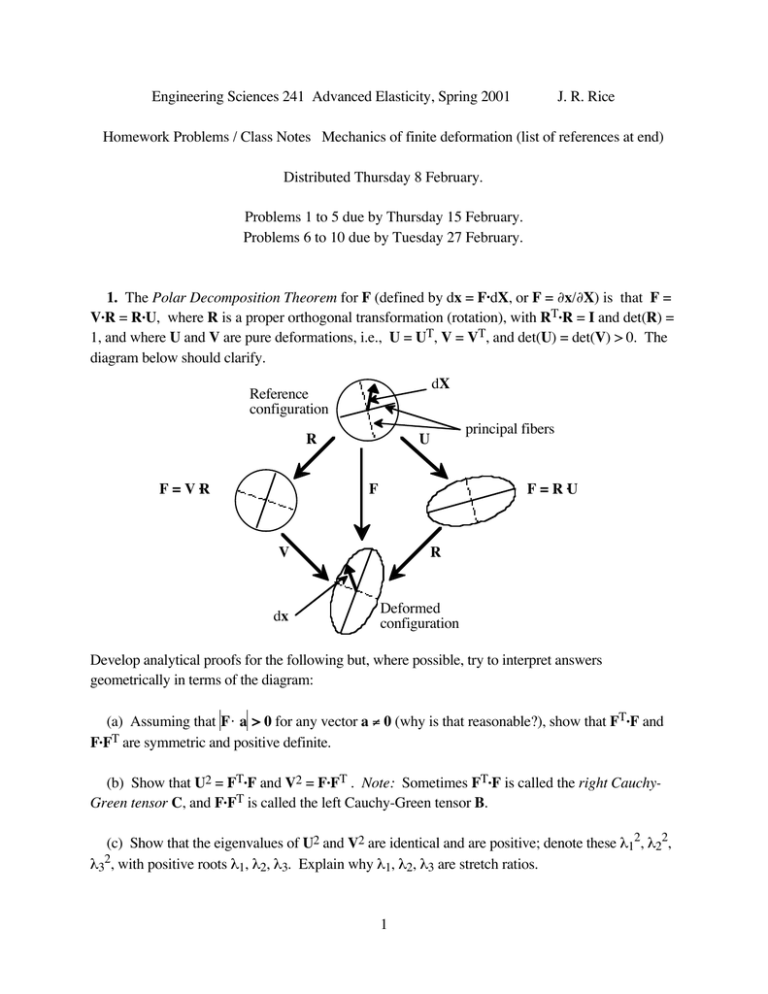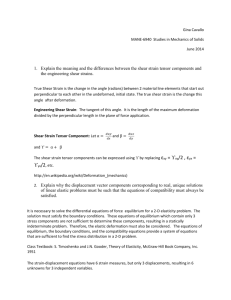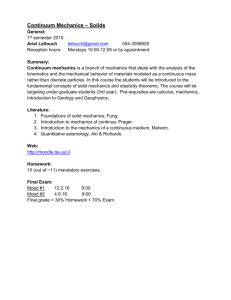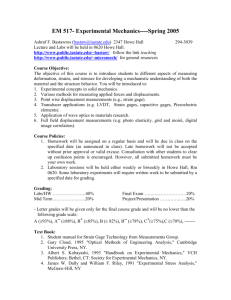Engineering Sciences 241 Advanced Elasticity, Spring 2001 ... Homework Problems / Class Notes Mechanics of finite...
advertisement

Engineering Sciences 241 Advanced Elasticity, Spring 2001
J. R. Rice
Homework Problems / Class Notes Mechanics of finite deformation (list of references at end)
Distributed Thursday 8 February.
Problems 1 to 5 due by Thursday 15 February.
Problems 6 to 10 due by Tuesday 27 February.
1. The Polar Decomposition Theorem for F (defined by dx = F.dX, or F = ∂x/∂X) is that F =
V.R = R.U, where R is a proper orthogonal transformation (rotation), with RT.R = I and det(R) =
1, and where U and V are pure deformations, i.e., U = UT, V = VT, and det(U) = det(V) > 0. The
diagram below should clarify.
dX
Reference
configuration
R
F = V ⋅R
principal fibers
U
F
F = R ⋅U
V
dx
R
Deformed
configuration
Develop analytical proofs for the following but, where possible, try to interpret answers
geometrically in terms of the diagram:
(a) Assuming that F⋅ a > 0 for any vector a ≠ 0 (why is that reasonable?), show that FT.F and
F.FT are symmetric and positive definite.
(b) Show that U2 = FT.F and V2 = F.FT . Note: Sometimes FT.F is called the right CauchyGreen tensor C, and F.FT is called the left Cauchy-Green tensor B.
(c) Show that the eigenvalues of U2 and V2 are identical and are positive; denote these λ12, λ22,
λ32, with positive roots λ1, λ2, λ3. Explain why λ1, λ2, λ3 are stretch ratios.
1
(d) Letting u1, u2, u3 be the unit eigenvectors of U2 (= C) and v1, v2, v3 be the unit
3
3
i=1
i=1
eigenvectors of V2 (= B), show that U = ∑ λ i u i u i and V = ∑ λ i v i v i . Note that u1, u2,
u3 correspond to the orientations of the principal fibers in the reference configuration and v1, v2, v3
to their orientations in the deformed configuration.
3
3
i=1
i=1
(e) Show that F = ∑ λ i v i u i , that R = ∑ v i u i , and that U = RT.V.R .
2. Consider the finitely strained state of simple shear, x1 = X1 + γ X2 , x2 = X2 , x3 = X3 .
Try to construct concise and instructive (and easily readable!) derivations of the answers to (a), (b)
and (c) which follow.
(a) Find the greatest and least values of the principal stretches λ1, λ2, λ3 and of the principal
M
values of EM . [Ans.: λmax,min = 1 + γ 2 / 4 ± γ / 2 , Emax,min
= ±(γ / 2) 1 + γ 2 / 4 + γ 2 / 4 ]
(b) Assuming henceforth that γ > 0 , find the orientation of the unit vector N which was
aligned, in the undeformed configuration, with the fiber which was to undergo the greatest stretch.
[Ans.: N2 / N1 = 1 + γ 2 / 4 + γ / 2 ]
(c) Explain why the orientation of the unit vctor n which aligns, in the deformed configuration,
with the fiber of greatest stretch is given by n2 / n1 = N2 / (N1 + γ N2) , where (N1, N2) is N
above, and thus solve for n2 / n1 . [Ans.: n2 / n1 = 1 / ( 1 + γ 2 / 4 + γ / 2 ), which is the inverse
of N2 / N1 given in the last part.] Note: Since n2 / n1 here is the inverse of N2 / N1 in (b) , then
if N makes an angle 45° + φ with the 1 direction, n makes an angle of 45° – φ with that
direction; φ is a small angle when γ is small.
(d) Consider the strain γ = 3/2. Show from part (a) above that λmax = 2 , λmin = 1 / 2, and
from the results of parts (b) and (c), solve for the unit eigenvectors u1, u2, u3 and v1, v2, v3.
[Partial answer: If λ1 = λmax , then u1 = (e1 + 2e 2 ) / 5 , v1 = (2e1 + e2 ) / 5 .]
(e) For γ = 3/2, solve for, and compare with one another, the cartesian components of the
following: the infinitesimal strain tensor ε (which is, of course, irrelvant at such large deformation
M
gradients), the Green strain (or change-of-metric strain) E based on g(λ) = (λ2–1)/2, and the
B
Biot strain E based on g(λ) = λ–1. The latter two are members of the family of material strain
3
M
tensors defined by E = ∑ g(λ i ) u i u i with g(1) = 0 and g'(1) = 1. Check your results for E
i=1
via that mode of expression with what you can calculate from E M = ( FT ⋅ F − I) / 2 .
3. Consider an isotropic elastic material, for which we may make (among various equivalent
2
forms) the representation of stress-strain relations σ = h0 I + h1B + h2 B2 for Cauchy stress σ,
where B = F.FT is the left Cauchy-Green tensor and where h0, h1, h2 are functions of the invariants
I1, I2, I3 of B.
(a) Show that an equivalent representation is σ = m0 I + m1 B + m2 B –1, and derive
expressions for the functions m0, m1, m2 in terms of h0, h1, h2 and I1, I2, I3 . [Hint: B−1 is an
isotropic function of B, so we can write B –1 = n 0 I + n 1 B + n 2 B 2 , which is equivalent to
I = n 0 B + n 1 B 2 + n 2 B 3 . To determine the scalars n0, n1, n2 involved here, note that B must
satisfy its own characteristic value equation, so that 0 = – B 3 + I1 B 2 – I2 B + I3 I .]
(b) Show that the second Piola-Kirchhoff stress S (i.e., the stress which is work-conjugate to the
Green strain; look ahead to problem 6) for this same elastic material is
S = I3 ( m0 C –1 + m1 I + m2 C −2 ) where C = FT.F = I + 2 EGreen is called the right CauchyGreen tensor and where m0, m1, m2 are the same functions of I1, I2, I3 as above; note that I1, I2, I3
are also the invariants of C. Note: By considerations like in part (a), this means that S has the form
S = g0 I + g1C + g2C2 where g0 , g1, g2 are functions of the invariants I1, I2, I3 of C -- which are
the same as the invariants I1, I2, I3 of B.
4. Consider again the simple shear of problem 2 for an isotropic elastic material.
(a) Using σ = m0 I + m1 B + m2 B –1 as above, explain why m0, m1, m2 are functions of γ2
(i.e., are even functions of γ) and write the cartesian components σ11, σ12, σ22, σ33 of σ in terms of
γ and the functions m0, m1, m2. (Note that when we retain terms beyond the linear in γ, the
imposition of simple shear strain requires not only shear stress, but also normal stresses which are
even in γ; the presence of these normal stresses is known as the Poynting effect.)
(b) Show that the results of part (a) imply that σ11 – σ22 = γ σ12 must hold for any elastic
material in simple shear, and develop a direct derivation of that result from consideration of
principal directions in simple shear.
5. Write the Cauchy stress as σ = σij e i e j = σij e i e j (summation on repeated indices) where
the orthogonal unit base vectors e i (i = 1,2,3) happen to coincide with the fixed cartesian
background base vectors e i at the moment considered, but rotate relative to them with spin Ω. Here
Ωij = antisym(vi,j) = (1/2) ( vi,j – vj,i ) and de j / dt = Ω ⋅ e j = Ω ⋅ e j = Ω ki e k at the moment
*
*
considered. The corotational (Jaumann) stress rate σ is then defined by σ = σij e i e j . Show
3
that
σ* = σ + σ⋅ Ω – Ω⋅ σ (i.e., σ*ij = σ ij + σik Ω kj – Ωik σkj ).
6. Various stress measures may be inter-related by the expression for work (per unit volume of
reference state) associated with a change δ F in the deformation gradient. That is,
t:δF = τ:(δF ⋅ F −1 ) = S:δE , where:
• t = nominal stress (tT = first Piola-Kirchhoff stress),
• τ = σ det(F) = Kirchhoff stress, where σ = Cauchy (or "true") stress, and
3
• S = ST = stress conjugate to strain E = ∑ g(λ i ) u i u i with g(1) = 0 and g'(1) = 1.
i=1
(When E is the strain based on change of metric, or the Green strain, EM = (1/2) (FT.F – I),
generated by g(λ) = (λ2–1)/2, the associated S is called the second Piola-Kirchhoff stress, denoted
SPK2 below.) The rate of deformation tensor D, defined by Dij = sym(vi,j), so that
(∇v)T = F⋅ F –1 = D + Ω, is used in what follows.
(a) Show that when the current state and reference state happen to be momentarily coincident,
t = τ * – σ⋅ D – D⋅ σ + σ⋅ (∇v) and that S PK2 = τ * – σ⋅ D – D⋅ σ, where τ * = σ * + σ tr(D).
(b) Show that any E has the series representation E = EM + (m–1) EM⋅ EM +... in terms of
Green strain, where m = [g''(1) + 1]/2, and thus show that the rate of the S conjugate to that E is
S˙ = τ˙ * − m(σ ⋅ D + D ⋅ σ ) , again when the current and reference states are momentarily coincident.
(Observe also that since the logarithmic strain, generated by g(λ) = lnλ, has m = 0, the stress
conjugate to logarithmic strain satisfies S = τ * momentarily.)
(c) Suppose that a particular rate-independent solid satisfies the constitutive relation τ * = Lo:D
where Loijkl is the set of incremental moduli, necessarily symmetric under interchange of ij and
chosen to be symmetric under interchange of kl. Explain why the moduli Loijkl must also be
symmetric under interchange of the pair ij with kl when the material is hyper elastic, so that a strain
energy exists.
(d) The constitutive relation for this same material as in (c) may be rewritten in terms of any
conjugate stress and strain measures, in the form S = L:E. Show that in the simple situation when
the current and reference configurations momentarily coincide,
4
m
o
L ijkl = Lijkl – (δ ik σ jl + δ il σ jk + σ ik δ jl + σ il δjk ) .
2
(Note that symmetry under the interchange of the pair ij with kl thus applies for all, or for no,
choices of conjugate strain and stress measures.)
7. Consider a hyperelastic material with strain energy density W = W(F) per unit volume of
reference configuration. Since t:δF (= tij δFji ) = δW, it follows that the nominal stress is given
by tij = ∂W(F)/∂Fji = ∂W(∂u/∂X)/∂(∂uj/∂Xi).
(a) Explain why invariance of the strain energy to a superposed rigid rotation of material
elements allows us to write W = W(E), where E is any member of the family of material strain
tensors discussed above, and show that when E is chosen as EM, and W is chosen to depend
symmetrically on the components of EM, that t = [∂W(EM)/∂EM]⋅ FT. [Observe that this equation
automatically satisfies F⋅ t = (F⋅ t)T ( i.e., that σ = σT, since F⋅ t = det(F) σ ) which is the only
consequence of the angular momentum principle not derivable on the basis of the linear momentum
principle.]
(b) When a material is isotropic, it will suffice to assume that W depends only on the invariants
of E, which is the same as assuming that it depends only on the invariants of C (the right CauchyGreen tensor). These are defined by det(C–µI) = – µ3 + I1µ2 – I2µ + I3 (where µ denotes λ2)
and are given as I1 = tr(C), I2 = {[tr(C)]2 – C:C}/2, I3 = det(C). Verify with W = W( I1, I2, I3)
that the form of stress strain relations given in part (a) leads to an expression for σ that is consistent
with what is stated in problem 3.
8. A hyperelastic solid is homogeneous in its reference configuration. Let So denote a closed
surface in that configuration, with unit outer normal N.
(a) Assuming that the solid is free of body force and that So encloses no singularities, show that
any deformation field u = u(X) sustained by the solid satisfies the Eshelby conservation integrals
So
[ Ni W(∂u/∂X) – Nj
∂W(∂u/∂X)
∂(∂uk /∂X j )
∂uk /∂X i ] dSo = 0
9. The incremental form of the principle of virtual work, appropriate to the quasistatic rate of
5
deformation problem, is
Vo
tij δ(∂uj /∂X i ) dVo =
o
Vo
fi δui dVo +
o
Ti δui dSo.
So
(a) Letting the reference configuration in which this is written be momentarily coincident with
the current state, so that Vo coincides with V and So with S, show that the left side of this equation
has the possible rearrangements
[ τ*ij δDji – 1 σij δ(2Dik Dkj – v k,i v k,j ) ] dV and
2
V
[ S ij δDji + 1 σij δ(v k,i v k,j ) ] dV
2
V
where S = SPK2 in the latter form, and where Dij = sym(vi,j).
(b) Suppose that the constitutive relation is given in the form τ*ij = Lοijkl Dkl . Discuss the
formulation of a finite element procedure for the rate problem, assuming that {∆} denotes nodal
displacements and that the velocity field in the current configuration is interpolated by
{v} = [B(x)]{∆}. In getting equations [K]{∆} = {F}, you should identify three types of
contribution to the tangent stiffness [K], one involving Lo that is formulated just as in conventional
"small strain" theory, another involving the current stress σ, and yet another stemming from the fact
o
that, often, the nominal stress loading rate T is not fully specified on the surface but depends on
the deformation itself (consider a pressure loading).
10. A (hyper)elastic solid is under a stress distribution σ in its reference configuration, and we
consider a field of small displacements u from that configuration, induced by additional nominal
loadings To over a part ST of its surface, the rest of the surface being fixed against further
displacement (i.e.,the loadings To are additional to the N ⋅ σ necessary to create the initial stress
state σ). Let L be the modulus tensor, in terms of SPK2, in the linearized relation S = σ + L:E.
(a) Show that the displacement field within the body makes stationary the potential energy
Π=
1
2 Vo
[ Lijkl u i,j u k,l + σij (uk,i uk,j ) ] dVo –
STo
Toi ui dSo
where here the energy is approximated to quadratic order only.
(b) In the case of a critically loaded Euler column, the variational problem δΠ = 0 evidently has a
6
solution when To = 0. Discuss the buckling problem from that standpoint and, using
approximations appropriate for a thin column, calculate the buckling stress. (See the Prager book if
you get stuck on this.)
References:
Z. P. Bazant, A correlative study of formulations of incremental deformation and stability of
continuous bodies, Journal of Applied Mechanics, vol. 38, pp. 919-928, 1971.
Z. P. Bazant and L. Cedolin, Stability of Structures: Elastic, Inelastic, Fracture and Damage
Theories, Oxford, 1991 (see Chp. 11).
P. Chadwick, Continuum Mechanics, Wiley, 1976.
M. E. Gurtin, An Introduction to Continuum Mechanics, Academic, 1981.
R. Hill, Some basic principles in the mechanics of solids without a natural time, Journal of the
Mechanics and Physics of Solids, vol. 7, pp. 209-225, 1959.
R. Hill, On constitutive inequalities for simple materials, I and II, Journal of the Mechanics and
Physics of Solids, vol. 16, pp. 229-242, 1968.
J. W. Hutchinson, Plastic buckling, in Advances in Applied Mechanics, vol. 14, Academic Press, pp.
67-144, 1974 (see Sect. III).
J. Lubliner, Plasticity theory, Macmillan, 1990 (see Chp. 8).
L. E. Malvern, Introduction to the Mechanics of a Continuous Medium, Prentice-Hall, 1969 (see
especially Sect. 4.5, 4.6, 5.3, 6.7 and 6.8).
R. M. McMeeking and J. R. Rice, Finite-element formulations for problems of large elastic-plastic
deformations, International Journal of Solids and Structures, vol. 11, pp. 601-616, 1975.
W. Prager, Introduction to Mechanics of Continua, Ginn and Co., 1961; reissue, Dover, 1973 (see
Chp. IX and X).
C. Truesdell and W. Noll, The nonlinear field theories of mechanics, in Handbuch der Physik 3(3),
Springer-Verlag, 1965.
7





